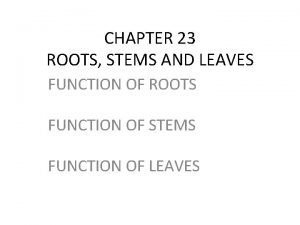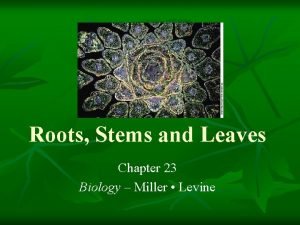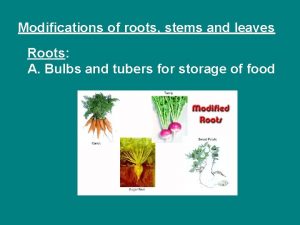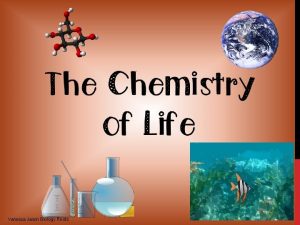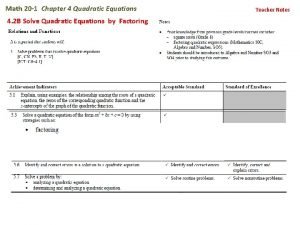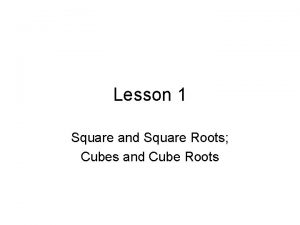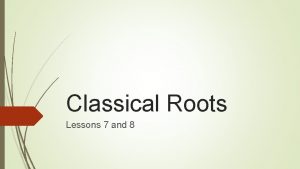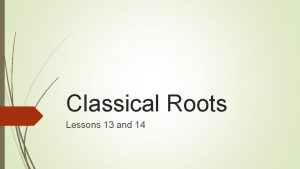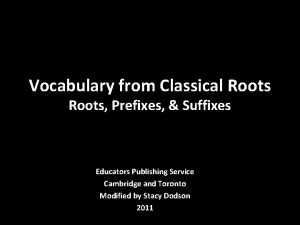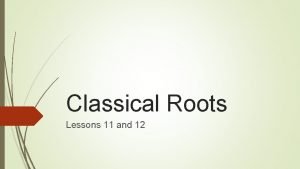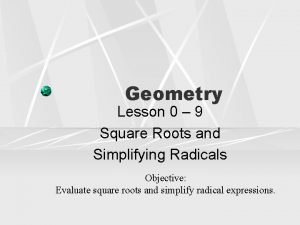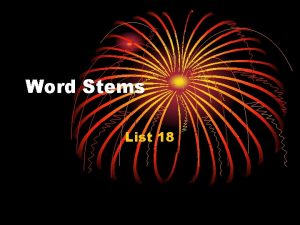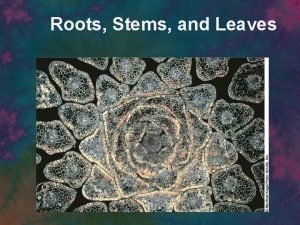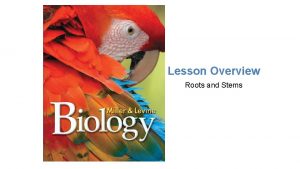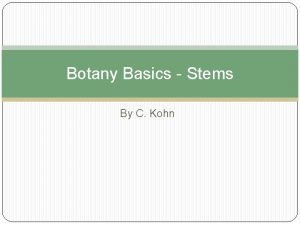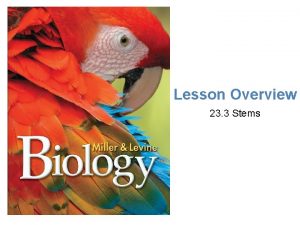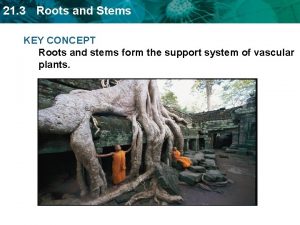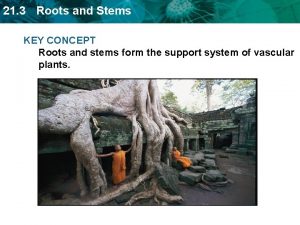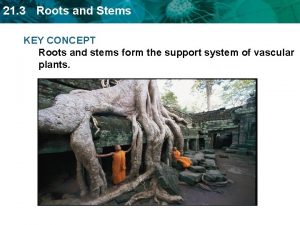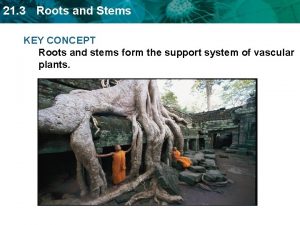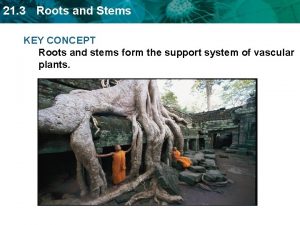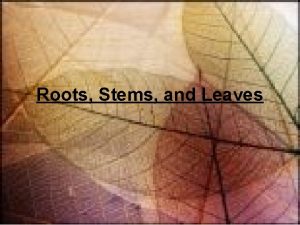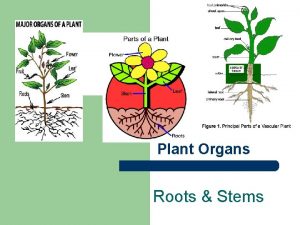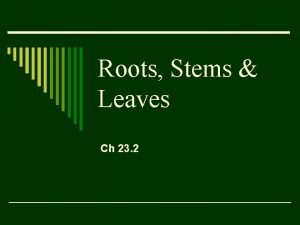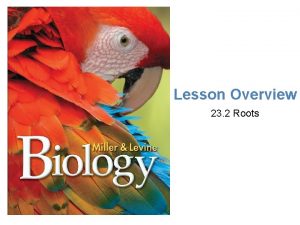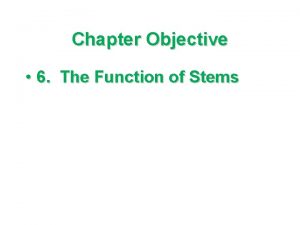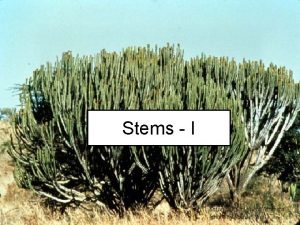CHAPTER 23 Lesson Overview 23 1 Roots Stems


















- Slides: 18

CHAPTER 23 Lesson Overview 23. 1 Roots, Stems, and Leaves

Lesson Overview Roots Types of Root Systems • The two main types of root systems are taproot systems and fibrous root systems. • Taproot systems are found mainly in dicots. • Dandelions have a taproot system. • Fibrous root systems are found mainly in monocots. • Grasses have a fibrous root system.

Lesson Overview Roots Taproot System • In some plants, the primary root grows long and thick and gives rise to smaller branch roots. The large primary root is called a taproot.

Lesson Overview Roots Fibrous Root System • In other plants, such as grass, the system begins with one primary root. But it is soon replaced by many equally sized branch roots that grow separately from the base of the stem. • The extensive fibrous root systems produced by many plants help prevent topsoil from being washed away by heavy rain.

Lesson Overview Roots Anatomy of a Root • As seen in the figure, a mature root has an outside layer of dermal tissue, called the epidermis, and also contains vascular tissue and a large area of ground tissue. • The root system plays a key role in water and mineral transport.

Lesson Overview Roots Dermal Tissue: Epidermis + Ground Tissue • The root’s epidermis performs the dual functions of protection and absorption. • The surface is covered with thin cellular projections called root hairs, which penetrate the spaces between soil particles and produce a large surface area that allows water and minerals to enter. • Just inside the epidermis is a region of ground tissue called the cortex. • Water and minerals move through the cortex from the epidermis toward the center of the root.

Lesson Overview Roots Ground Tissue A layer of ground tissue known as the endodermis completely encloses the vascular cylinder. Vascular Tissue At the center of the root, the xylem and phloem together make up a region called the vascular cylinder.

Lesson Overview Roots Apical Meristem • Roots grow in length when apical meristems produce new cells near the root tips. • A tough root cap protects the meristem as the root tip forces its way through the soil, secreting a slippery substance that eases the progress of the root through the soil. • Cells at the tip of the root cap are constantly being scraped away, and new root cap cells are continually added by the meristem.

Lesson Overview Roots Stem Structure and Function • Aboveground stems have several important functions: Stems produce leaves, branches, and flowers; stems hold leaves up to the sun; and stems transport substances throughout the plant. • Stems make up an essential part of the water and mineral transport systems of the plant. • Xylem and phloem form continuous tubes from the roots through the stems to the leaves. These vascular tissues allow water, nutrients, and other compounds to be carried throughout the plant. • In many plants, stems also function in storage and aid in the process of photosynthesis.

Lesson Overview Roots Anatomy of a Stem • Stems contain dermal, vascular, and ground tissue. • Stems are surrounded by a layer of epidermal cells that have thick cell walls and a waxy protective coating. • These cross sections through a monocot and dicot stem show the epidermis, vascular tissue, and ground tissue.

Lesson Overview Roots Anatomy of a Stem • Growing stems contain distinct nodes, where leaves are attached, as shown in the figure. • Small buds are found where leaves attach to the nodes. Buds contain apical meristems that can produce new stems and leaves. • In larger plants, stems develop woody tissue that helps support leaves and flowers.

Lesson Overview Roots Vascular Bundle Patterns • In monocots, clusters of xylem and phloem tissue, called vascular bundles, are scattered throughout the stem, as shown in the cross section below left. • In most dicots and gymnosperms, vascular bundles are arranged in a cylinder, or ring, as shown in the cross section below right.

Lesson Overview Roots Primary Growth • A plant’s apical meristems at the roots and shoots produce new cells and increase its length. This growth, occurring at the ends of a plant, is called primary growth. It takes place in all seed plants. • The figure below shows the increase in a plant due to primary growth over several years.

Lesson Overview Roots Secondary Growth • As a plant grows larger, the older parts of its stems have more mass to support and more fluid to move through their vascular tissues. As a result, stems increase in thickness, which is known as secondary growth. • The figure below illustrates the pattern of secondary growth in a dicot stem.

Lesson Overview Leaves Anatomy of a Leaf • To collect sunlight, most leaves have a thin, flattened part called a blade. The flat shape of a leaf blade maximizes the amount of light it can absorb. • The blade is attached to the stem by a thin stalk called a petiole. • Leaves have an outer covering of dermal tissue and inner regions of ground and vascular tissues.

Lesson Overview Leaves Dermal Tissue • The top and bottom surfaces of a leaf are covered by the epidermis, which has tough, irregularly shaped cells with thick outer walls. • The epidermis of nearly all leaves is covered by a waxy cuticle, a waterproof barrier that protects the leaf and limits water loss through evaporation. Vascular Tissue • Xylem and phloem tissues are gathered together into bundles called leaf veins that run from the stem throughout the leaf.

Lesson Overview Leaves Photosynthesis • Beneath the upper epidermis is a layer of cells called the palisade mesophyll, containing closely packed cells that absorb light that enters the leaf. • Beneath the palisade layer is the spongy mesophyll, which has many air spaces between its cells. • The air spaces in the spongy mesophyll connect with the exterior through stomata, small openings in the epidermis that allow carbon dioxide, water, and oxygen to diffuse into and out of the leaf.

Lesson Overview Leaves Transpiration & Gas Exchange • Transpiration is the loss of water through leaves. This lost water may be replaced by water drawn into the leaf through xylem vessels in the vascular tissue. • Leaves take in carbon dioxide and give off oxygen during photosynthesis. • When plant cells use the food they make, the cells respire, taking in oxygen and giving off carbon dioxide. • Plant leaves allow gas exchange between air spaces in the spongy mesophyll and the exterior by opening their stomata.
 Section 23-2 roots answer key
Section 23-2 roots answer key What are three important functions of stems
What are three important functions of stems Modification of roots
Modification of roots Vanessa jason www.biology-roots.com
Vanessa jason www.biology-roots.com Square root 1 to 100
Square root 1 to 100 Existence and uniqueness of square roots and cube roots
Existence and uniqueness of square roots and cube roots The roots of american imperialism 1. economic roots
The roots of american imperialism 1. economic roots Quadratic equation with roots
Quadratic equation with roots What are all of the perfect squares
What are all of the perfect squares Chapter 9 lesson 2 photosynthesis an overview
Chapter 9 lesson 2 photosynthesis an overview Lesson overview
Lesson overview Roots, prefixes and suffixes lesson 7 answer key
Roots, prefixes and suffixes lesson 7 answer key Classical roots lesson 7 and 8 answers
Classical roots lesson 7 and 8 answers Vocabulary from classical roots lesson 13 and 14 answers
Vocabulary from classical roots lesson 13 and 14 answers Vocabulary from classical roots book c lesson 9 answers
Vocabulary from classical roots book c lesson 9 answers Classical roots lesson 11 and 12 answer key
Classical roots lesson 11 and 12 answer key Lesson 0-9 square roots and simplifying radicals answers
Lesson 0-9 square roots and simplifying radicals answers How to simplify square root fractions
How to simplify square root fractions Stems list 1
Stems list 1
